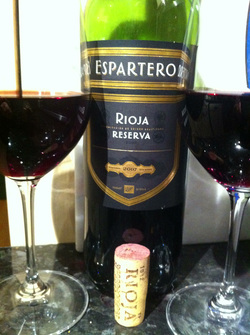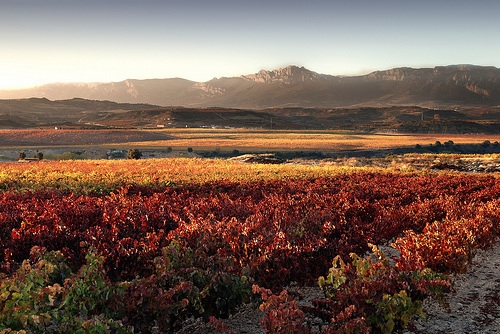
This week, we toasted Spain again with a Rioja Reserva called Espartero, priced at £5.50 (rolled back from £7.98). I was a Rioja drinker of long standing until I met Mr Purple Teeth, but he deemed the wines he first tasted 10 years ago to be "sherry-ish" (a hint of oxidation?), and they didn't grab him in the way that Bordeaux wines tickled his tastebuds. So, my love affair with Rioja dwindled to nothing more than a casual fling from time to time. No commitment, and no questions asked.
It was time to get re-acquainted and I invited Mr Purple Teeth in for a threesome.
 12.5% abv £5.50 from Asda
12.5% abv £5.50 from Asda "That's not bad. It's a big wine. Good mouthfeel, plenty of body. It can't be Rioja can it?"
Well Rioja it is, and the salty seal of approval was a great result for a wine in this price range.
To clear something up: you can get white and rosé wine from Rioja too, and jolly nice it is! But all of the information in this post will be about the more famous red Rioja, or specifically about our Wine of the Week.
When buying Rioja, you need to understand a little bit about the Spanish labelling terms to work out in advance what the wine might actually taste like. Rioja wines are generally made from Tempranillo grapes (occasionally with a small proportion of a couple of other indigenous grapes in the blend, such as Garnacha and Graciano), but all Riojas are not created equal, and I'm not just referring here to the different strains of Tempranillo out there. Let's not get into that level of detail just yet!
The most obvious difference between Riojas, aside from winemaker style, quality and cost, is the recognised and regulated Crianza aging system. Keep in mind that such terms as Reserva have a legal meaning in Spain (Portugal and Italy too, though the meaning is a little different), whereas terms like Reserve are often just clever marketing in other parts of the world.
.
Joven: means ‘young’ and implies that the wine is fresh, probably from the most recent harvest/vintage (or Cosecha). It has probably spent little, or (most likely) no time in contact with oak during the wine making process. If you have a Joven on the shelf, don't think about keeping it for 5 years. It won't suddenly become a Gran Reserva, and the wine is made to be drunk while young, fresh and fruity. You'll often find this style of Rioja in wine bars as it's generally soft and easy to drink, can be food friendly but doesn't need food to be at it's best. Note that the vast majority of white and rosado (rosé) wines from Rioja fall into the Joven category. Occasionally the wine may not say Joven, but instead just say Cosecha along with the year of harvest. At times, this may be supplemented by a phrase such as ‘X’ Meses en Barrica or simply Roble, implying the wine has spent some time in oak barrels, but not enough to qualify as a Crianza or one of the other aging levels.
(For those rare white or rosado wine that are labelled Crianza, wines are required to spend at least 6 months in oak and 6 in bottle.)
 A standard Reserva label. They're colour coded
A standard Reserva label. They're colour coded (White and rosado wines Reserva wines are even rarer, but if you see them, they'll have spent a minimum of six months in oak and and 18 months in the bottle before being released for sale).
Gran Reserva: meaning 'great reserve' wines are the most expensive and, reputedly, the best Riojas, though that's all a question of taste. They're aged for at least 5 years with a minimum of 24 months in oak and 36 months in the bottle. Many will spend several more years aging before being released. Despite their hefty prestige and price tag, Gran Reserva wines in the past could become overly oxidized and excessively woody, losing fruit and giving that sherry tinge that Mr Purple Teeth found so unappealing. Modern winemaking techniques and the improved care of the best wine-makers now means this perceived problem is rare. The long aging allows Gran Reserva wines to marry a perfect blend of fruit and oak creating wines with complex flavours and a long finish.

It's a Reserva, meaning it's had a year in oak, and has had twice the legal minimum of bottle aging so it's certainly ready to drink now. Considering the attention needed to create a Reserva wine, at £5.50 this is definitely a bargain. It's undoubtedly the cheapest 2007 Reserva I was able to find, and it's far more common to find them at twice this price. But it's only a bargain if it's any good. If you like the Reserva style of Riojas, then you'll like this. It may not be the most complex, and it doesn't have a particularly long finish, but it's well integrated, smooth as silk (especially coming back to drink it on day two), and packs a punch of black plum veering to prune, with vanilla and spice, and a hint of leather. If you're going to be making spring roast lamb a Sunday staple for the next month or two, then grab a few bottles of this and you can't go wrong.
Did the Purple Teeth public agree? Please tell me in the blog comments area. I'd love to know if you agree.
Or you could just buy a few more and learn by tasting. Next week's wine of the week will be Cono Sur Viognier in the Bicicleta range from Chile. It's rolled back from £7.48 to £5 at Asda so grab a bottle and tell me what you think.
Cheers! Salud!



 RSS Feed
RSS Feed
